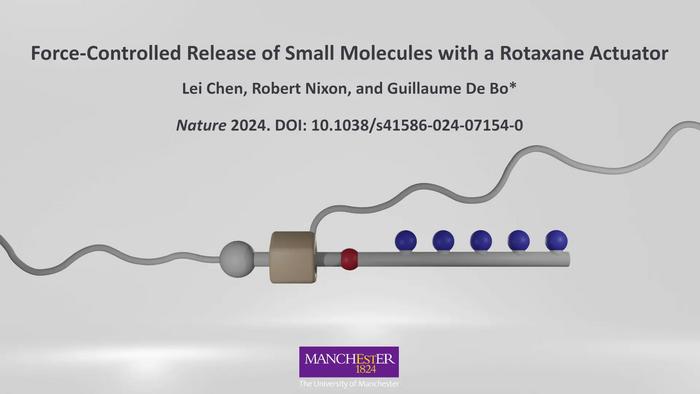In a new breakthrough that could revolutionise medical and material engineering, scientists have developed a first-of-its-kind molecular device that controls the release of multiple small molecules using force.

Credit: Prof De Bo, The University of Manchester
In a new breakthrough that could revolutionise medical and material engineering, scientists have developed a first-of-its-kind molecular device that controls the release of multiple small molecules using force.
The researchers from The University of Manchester describe a force-controlled release system that harnesses natural forces to trigger targeted release of molecules, which could significantly advance medical treatment and smart materials.
The discovery, published today in the journal Nature, uses a novel technique using a type of interlocked molecule known as rotaxane. Under the influence of mechanical force – such as that observed at an injured or damaged site – this component triggers the release of functional molecules, like medicines or healing agents, to precisely target the area in need. For example, the site of a tumour.
It also holds promise for self-healing materials that can repair themselves in situ when damaged, prolonging the lifespan of these materials. For example, a scratch on a phone screen.
Guillaume De Bo, Professor of Organic Chemistry at The University of Manchester, said: “Forces are ubiquitous in nature and play pivotal roles in various processes. Our aim was to exploit these forces for transformative applications, particularly in material durability and drug delivery.
“Although this is only a proof-of-concept design, we believe that our rotaxane-based approach holds immense potential with far reaching applications – we’re on the brink of some truly remarkable advancements in healthcare and technology.”
Traditionally, the controlled release of molecules with force has presented challenges in releasing more than one molecule at once, usually operating through a molecular “tug of war” game where two polymers pull at either side to release a single molecule.
The new approach involves two polymer chains attached to a central ring-like structure that slide along an axle supporting the cargo, effectively releasing multiple cargo molecules in response to force application. The scientists demonstrated the release of up to five molecules simultaneously with the possibility of releasing more, overcoming previous limitations.
The breakthrough marks the first time scientists have been able to demonstrate the ability to release more than one component, making it one of the most efficient release systems to date.
The researchers also show versatility of the model by using different types of molecules, including drug compounds, fluorescent markers, catalyst and monomers, revealing the potential for a wealth of future applications.
Looking ahead, the researchers aim to delve deeper into self-healing applications, exploring whether two different types of molecules can be released at the same time. For example, the integration of monomers and catalysts could enable polymerization at the site of damage, creating an integrated self-healing system within materials.
They will also look to expand the sort of molecules that can be released.
Prof De Bo said: “We’ve barely scratched the surface of what this technology can achieve. The possibilities are limitless, and we’re excited to explore further.”
Journal
Nature
Article Title
Force-controlled release of small molecules with a rotaxane actuator
Article Publication Date
10-Apr-2024



